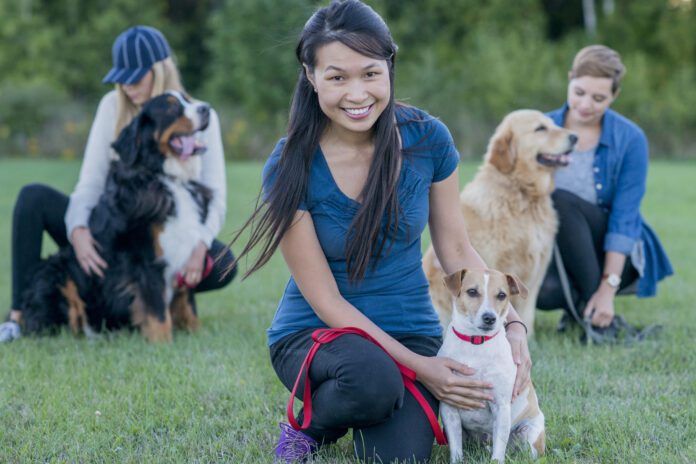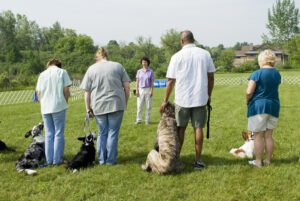
Finding a good trainer for you and your dog may sound simple, but it’s not. Sure, you can search online or ask your veterinarian, groomer, or your dog-owning friends whom they recommend. That doesn’t mean you’re going to find the trainer who’s right for you or your dog.
An online search or a reference from an acquaintance might help you find a decent trainer. Just keep in mind that there are no legal requirements in the U.S. for someone to call themselves a dog trainer or behaviorist. Your plumber could hang out his dog trainer shingle tomorrow with absolutely no dog training experience and start working with clients.
Trainers referred by your friends and animal care professionals may – or may not – be up to speed on what are current and best practices in the dog training profession. And they may – or may not – use safe, effective, and humane training methods.
As a professional trainer myself, I’d like to share with you how I would go about finding and choosing a dog trainer.
Where to look for training candidates
The most reliable places to search are trainer directories of professional organizations that have education requirements and hold their students, members, or certificants to reasonable standards in the application of humane, science-based dog training methods and ethics.
Training and behavior professionals who care about professional standards pursue ongoing education and membership in and certification offered through one or more dog-training organizations and companies. We have a strong preference for professionals who have been certified by organizations that support and promote dog-friendly training, including all of the ones in the sidebar, “Recommended Dog-Trainer Certifying Organizations,” below.
Research Your Dog Trainer
Once you find a certified professional near you, however, your real job has just begun; you’ll need to do some research to make sure the candidate is suitable.
Start by looking at the candidate’s website. Read the information there and scrutinize the photos. While certifying organizations do their best to ensure that members are adhering to their mission and ethics, sadly that’s not always the case. If you see photos of dogs wearing prong or shock collars on the website, cross that trainer off your list!
Also check out the candidate’s social media (Facebook, Instagram, TikTok) to confirm that the text, photos, and videos displayed there are congruent with your own force-free training philosophy. If they have a blog, read several of them. If they’ve written articles for publications, find and read them. If they’ve written a book or books, try to find and read (or skim) at least one. Make sure you are comfortable with everything you find.
Interview the trainer
I also recommend that you interview the trainer or their training staff. They should happily answer your questions about methods and training philosophy – after all, you’ll be entrusting them with your dog’s well-being! Have your questions ready before you call and feel free to add more if some come up for you during the discussion.
Here are questions that I’d recommend you ask a prospective trainer:
- What training and experience do you have? How long have you been working in the field? Look for a trainer who has made the effort to pursue her professional education and who has some boots-on-the-ground experience.
- What is your educational background? What do you do for continuing education? What certifications do you have? There are constantly new findings in behavioral science. Trainers should be certified by a professional organization that promotes dog-friendly training, and should stay current in the field with regular continuing education at educational conferences, workshops, and/or seminars.
- What is your training philosophy? Look for a trainer who is dedicated to a force-free training philosophy that allows the dog choice and agency, and seeks to create relationships between dog and human based on mutual love, trust, and respect.
- What do you do if a dog makes a mistake or doesn’t listen? The correct answer is, “Figure out how to help him get it right.” There is no place for “corrections” or physical or verbal punishment in modern, humane dog training.
- What methods and tools do you use? The answer here should be science-based “positive reinforcement” or “force-free.” Ask if they would ever use a choke (slip), prong (pinch), or shock collar (also called “electronic collars” or “e-collars”). We don’t recommend trainers who use these tools.
- Do you guarantee results? The answer here should be, “No!” Dogs and humans are sentient, unpredictable creatures, and no ethical professional guarantees training results. This is a classic sign of a bad or shady trainer.

When the trainer or their staff members answer your questions, listen – really listen – to their words. A recent study that examined the websites of 100 popular trainers found that trainers who use aversive methods are more likely to use the phrases like “pack leader,” “mother nature,” “electronic collar,” or “e-collar,” may talk about using a “balanced” approach, and brag about training without using treats.
In contrast, force-free trainers tend to talk about positive reinforcement, support the use of food in training, and are likely to call “electronic collars” by their more appropriate name: shock collars – and they don’t use them.
After talking to a trainer or her staff, ask to observe a training class. Make sure the trainer puts force-free training methods into practice, not just using buzzwords. Aversive and “balanced” trainers (those who use aversive training and positive reinforcement) have learned that there’s marketing value in the term “positive reinforcement” and they use it to attract clients. We’d keep looking if they mix treats and yanks on the leash.
Finally, ask for references: Good trainers are happy to supply you with contacts from past clients who can attest to their work. Don’t just look at them; call or email at least a couple to ensure that they are happy with their training experience.
These organizations have unique education and experience requirements for trainer certification. Each promotes dog-friendly training; some go a bit further and specifically disapprove of dog-training methods that include force, pain, or fear.
Academy for Dog Trainers
Created by Jean Donaldson (author of the groundbreaking book The Culture Clash), the Academy for Dog Trainers is a two-year, part-time online virtual university program for dog trainers, offering education in all aspects of dog training, dog behavior, behavior modification, and more. Find Academy graduates here.
Animal Behavior Society
The Animal Behavior Society certifies behavior professionals with advanced degrees and experience in applied animal behavior. Find Certified Applied Animal Behaviorists (CAABs) here.
Certification Council for Professional Dog Trainers
This organization requires its certificants, called Certified Professional Dog Trainers (CPDTs), to document at least 300 hours of training experience, provide references, and pass a written exam. CCPDT also certifies behavior professionals (CBCCs). Find CPDTs and CBCCs here.
International Association of Animal Behavior Consultants
The IAABC offers certification for behavior work with a variety of species, including dogs, cats, horses, and birds. Find Certified Dog Behavior Consultants (CDBC) here.
Karen Pryor Academy
Karen Pryor is a former marine mammal trainer and author of the landmark book Don’t Shoot the Dog (originally published in 1984), which launched the positive training movement. The Karen Pryor Academy, now administered by noted behavior professional Ken Ramirez, offers myriad courses, including the Dog Trainer Professional course, which awards a Karen Pryor Training Partner certification. Find KPA CTPs here.
Peaceable Paws LLC – Pat Miller Certified Trainer
I offer four levels of certification (PMCT) for trainers who have completed Peaceable Paws academies, starting with Basic Dog Training and Behavior and advancing through academies on Behavior Modification, Aggression, and Cognition Find PMCTs here.
Pet Professional Accreditation Board
The Pet Professional Accreditation Board (of the Pet Professional Guild) offers the only Accredited Training Technician & Professional Canine Trainer certification for professionals who believe there is no place for shock, choke, prong, pain, force, or fear in training and behavior practices. Find PPAB certificants here.
Veterinary Behaviorists
Veterinary behaviorists are veterinarians who have done an additional intensive course of study in animal behavior. They address relationships between an animal’s health, environment, experiences, and behavior. They have extensive knowledge of psychotropic medications and are licensed to prescribe them when indicated. Veterinary behaviorists can be found through the American College of Veterinary Behaviorists (here) and through the American Veterinary Society of Animal Behavior (here). The latter also provides a list of non-veterinary PhD behaviorists.
Victoria Stillwell Academy: School for Dog Trainers
Founded by world-renowned dog trainer Victoria Stilwell, the Victoria Stilwell Academy for Dog Training & Behavior educates and empowers aspiring dog training professionals to change the lives of people and dogs through positive training. Find VSA Certified Dog Trainers (VSA-CDTs) here.






Pat – good article, but I wonder why NADOI (National Association of Dog Obedience Instructors) was not mentioned as a trainer resource? As the oldest certifying trainer organization in the US with very high standards of certification I believe their certified instructors are among the best out there. Please consider adding a PS to this blog!
Thank you for this! This is the best one I’ve found. Checking social media is key and so is actually listing the orgs that require continuing ed. Also questions to ask and the correct answers!! It has become increasingly difficult for prospective client to sort through all the gaslighting going on. Hard for them to know which certifying orgs are legit and which are made up by a franchise or TV host. Professional looking websites often hide very unprofessional training tactics. I always advise people- One of the biggest red flags is no photos or videos of the trainers training dogs. As a force-free trainer I am transparent and proud of my work. Therefore training videos, photos, published articles and a free webinar are available on my social media. I list the tools I use and do not use. Thank you for this article. I’ll be bringing it to my shelter meeting tomorrow.